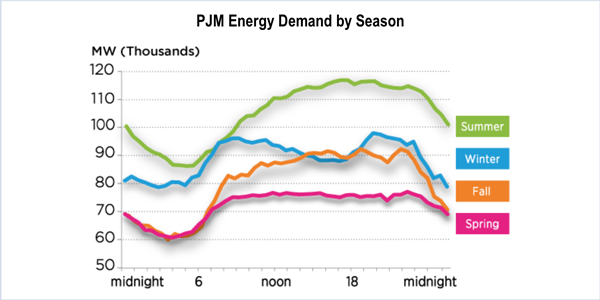By Rory D. Sweeney
In a move that should please environmental and ratepayer advocates, FERC has denied requests to shut down debate on whether PJM’s Capacity Performance construct should make room for seasonal resources that can’t adhere to CP’s requirement to always be available (EL17-36).
The commission on Friday dismissed two requests for rehearing of its February order calling for a technical conference on whether the PJM should move from a year-round to a seasonal capacity construct. The commission ordered the conference in response to two complaints, one from the Advanced Energy Management Alliance, and a combined filing from Old Dominion Electric Cooperative, Direct Energy and American Municipal Power. (See FERC Rethinking PJM Capacity Performance Rules.)
PJM and the PJM Power Providers Group (P3) argued that FERC should have dismissed the complaints for not providing new evidence or changed circumstances that would require a decision other than approving CP. P3 challenged FERC’s position that the complaints “raised important issues as to whether certain aspects of the [CP] construct are performing as well as expected.”
FERC rejected those arguments, saying it hadn’t made a final decision on the issue and that the February order was just to open the investigation. It rejected PJM’s argument that the complaints were collateral attacks on CP and said the complainants had proven that CP might be unjust and unreasonable.
“The fact that the commission accepted a rate design in a proceeding under Section 205 of the [Federal Power Act] does not preclude the commission from later re-examining that rate design in a subsequent FPA Section 206 proceeding,” the commission said.
FERC said AEMA identified seven “distinct developments since the conditional acceptances” of CP:
- multiple planning studies indicating that CP alone may not suit the region’s resource adequacy needs, and no study showing a winter resource adequacy shortfall;
- a new reliability analysis from PJM showing that nearly all the resource adequacy value of marginal capacity lies in the summer months;
- auction results that suggest CP will actually degrade resource adequacy by reducing needed peak-season capacity;
- new PJM load forecasting information showing that peak-shaving programs have little impact on future capacity purchases, contradicting prior assumptions;
- PJM stakeholder resolution of a previously deferred CP cost allocation component;
- auction offers showing that significant amounts of capacity have been unwilling or unable to take on CP obligations at any price and that the aggregation mechanism proposed for demand response, energy efficiency and intermittent renewables does not appear to be working; and
- indications that the combination of seasonal and annual capacity worked well during the phase-in of CP, as evidenced by PJM’s statements that its available capacity mix has been sufficient to meet demand.
FERC also found value in PJM sensitivity analyses presented in the complaints, settling arguments by PJM that they don’t provide new evidence or changing conditions because they’re solely backward-looking and completely hypothetical.
“We continue to find that these analyses constitute new evidence sufficient to warrant further investigation,” the commission wrote. “Given that PJM is a summer peaking system, these studies support the contention that the move to a single, annual capacity product may have pushed valuable summer-only resources out of the capacity market and thereby increased capacity costs with little or no reliability benefit. They indicate that allowing PJM to procure some capacity as summer-only capacity would allow PJM to procure significantly less capacity during non-summer periods and provide equivalent reliability at lower total capacity costs.”
FERC also rejected arguments that it’s too soon to determine whether anything’s wrong with CP.
“The concerns raised — including whether customers are paying more than necessary to ensure reliability — are the type of concerns that may be exacerbated, rather than ameliorated, by the passage of additional time,” the commission wrote.



